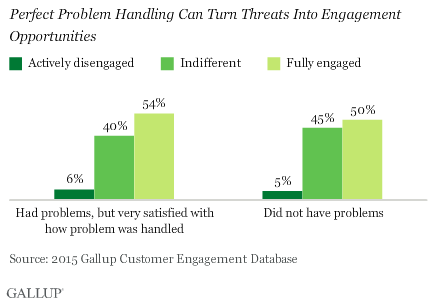Story Highlights
- Customer problems destroy customer engagement
- Problem handling is more important than problem resolution
- Top companies use problems as opportunities to engage customers
Most businesses aim to provide good customer service -- but sometimes, customers encounter problems in getting the products and services they want. When they do, those problems have a significant impact on customer engagement.
Gallup analysis reveals that 50% of customers who did not encounter a problem when purchasing a product or receiving a service are fully engaged. But when customers do encounter a problem, only 15% are fully engaged.

For businesses, that's a big deal. This is because fully engaged customers are emotionally and psychologically attached to the companies they do business with. They give a company more of their time and money, and they are its most loyal and vocal brand ambassadors. If customers continually encounter problems with a business, that business' number of fully engaged customers can diminish to nearly zero.
But all is not lost when problems occur. Companies can take steps to fix their mistakes and recover engagement. The key is to think beyond simply resolving a customer's problem, because there is a crucial difference between fixing a problem and engaging a customer.
Problem Handling Is More Important Than Problem Resolution
When customers encounter a problem, they want it to be resolved to their satisfaction. But when it comes to creating or maintaining customer engagement when a problem occurs, how a company handles a customer's problem matters just as much, if not more, to that customer than a successful resolution of the problem.
Companies don't absolve themselves in their customers' eyes by simply fixing a problem; they do so by taking care of the customer's emotional needs throughout the resolution process. When customers are very satisfied with the way in which their problem was handled, Gallup found that more than half (54%) are fully engaged. When customers are very satisfied with the resolution to their problem, in contrast, about three in 10 (27%) are fully engaged.

Surprisingly, when customers are very satisfied with the way their problem was handled -- regardless of whether the problem was resolved -- slightly more of them are fully engaged (54%) than customers who did not encounter a problem (50%). Companies should take every action to minimize or prevent problems from happening in the first place. But when problems occur -- and they will -- leaders who seek to maintain or increase customer engagement should be just as concerned about how their employees interact with customers throughout the resolution process as they are with ensuring the problem is resolved. When handled correctly, problems can become opportunities to increase customer engagement.

Problem Handling: Six Crucial Tactics
Customers expect to have problem-free interactions. They don't give out gold stars to companies for selling them a car that works, providing them with a clean hotel room or shipping their order on time -- these are entry-level standards for getting a customer's business. However, customers do expect that companies will always deliver on the promises they make. And always means always, not some of the time, not most of the time. For customers, the difference between what a company promises and what it actually delivers can earn or destroy a customer's engagement.
When problems occur, the best companies use them as opportunities to emotionally engage their customers. But before problems even happen, these companies look back to their brand promise and create a clearly defined strategy for resolving them. Gallup has found that these strategies are typically based on six crucial tactics that should be employed in the following order:
- Acknowledge the problem, listen carefully and let the customer finish. Most customers who have encountered a problem are frustrated with the company. They want an opportunity to vent, so giving them an opportunity to do so -- and listening carefully to what they say -- is crucial. Whether the interaction is in person or on the phone, the employee should actively listen to what the customer is saying and act as his or her advocate throughout the interaction. Above all, employees should not challenge a customer, but should seek to understand the problem and the customer's viewpoint. Gallup has found that customers who feel as though they are being listened to are 32 times more likely to be fully engaged, while customers who feel they are being rushed are nine times less likely to be fully engaged.
- Apologize -- no matter who is at fault -- and show empathy and care. An apology is an obvious first step in resolving a customer's problem, but it's one that rarely happens. Managing a customer's emotions is the key to building customer engagement, and it's far more important than trying to reason with him or her by reviewing the problem and offering possible solutions. In some cases, for example, the perceived problem occurred because of a misunderstanding on the part of the customer, not because the product or service provider was actually at fault. Even when this occurs, the company should still apologize, because it will help the customer feel that the company cares. And customers who feel as though they are being cared for are 27 times more likely to be fully engaged, compared with customers who do not feel this way.
- Personalize the conversation instead of reading from a transcript. Almost six in 10 customers say their experience was made worse when an employee read from a prepared script. Customers want conversations to feel genuine and personalized, not rehearsed. Companies can give employees basic guidelines to follow, but should encourage them to solicit customer input or present customers with choices related to solving their problem. This approach not only personalizes the conversation, it also encourages customers to take ownership of the solution -- which can help them feel more satisfied with how their call was handled.
- Handle problems on the spot. When customers' problems are resolved the first time they contact a call center, 28% are fully engaged. But if customers contact a call center twice, 15% are fully engaged, Gallup analysis shows. If customers have to call back more than twice to resolve their problem, only 8% are fully engaged. To prevent engagement drops like this from occurring, employees should feel empowered to individualize and provide appropriate resolution immediately.
- Designate a single point of contact and escalate only when necessary. Though hand-offs are undesirable, they are sometimes necessary. Companies should define their escalation procedures to help every team member know what problems must be escalated, how they will be resolved and what role each employee will need to play in the resolution process. But beware: Gallup has found that customers who interact with more than three people during a single call have almost no chance of being fully engaged. If employees must escalate a problem or bring in an expert to help resolve it, they should always let customers know they will personally follow up at a specified date and time. This attention makes customers feel that the company values their business and that it's committed to solving their problem. The worst thing that could happen is for a customer to call back because no one has provided an update -- because, by this point, customers are unlikely to be engaged regardless of the company's efforts to solve their problem.
- Leave the customer better off than before the problem. Customers should leave the interaction feeling as though their needs have been met now and for the foreseeable future. They want as much information as possible from employees and to know they have been listened to and understood. Employees should end the conversation by summarizing what the problem was, how it occurred and what actions the company will take to ensure it does not happen again.
